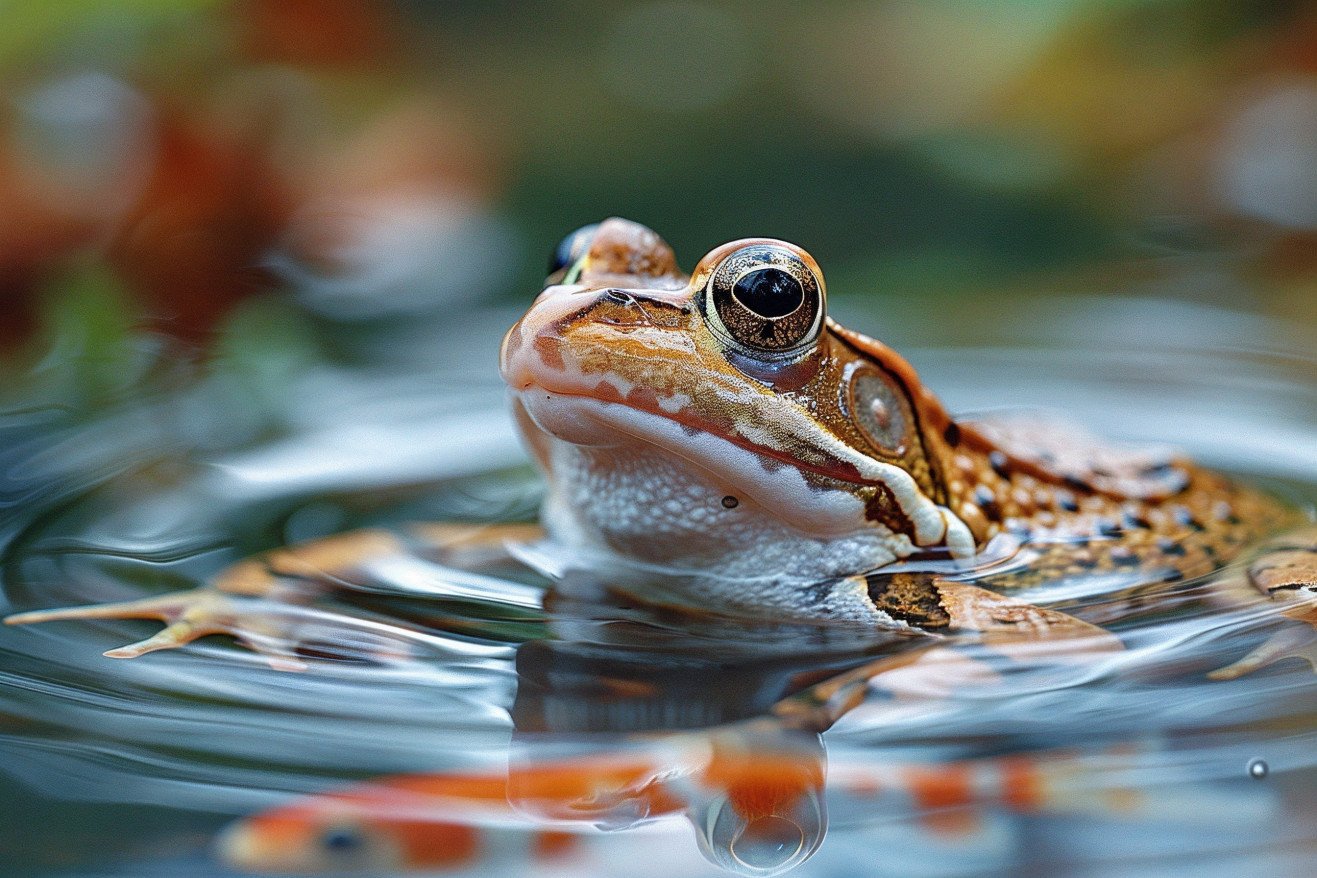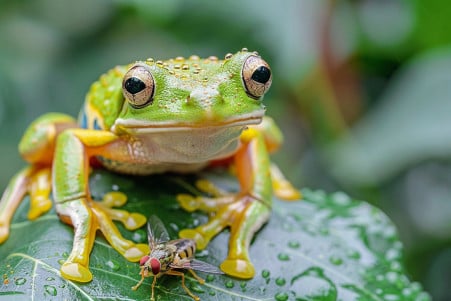What Do Frogs Eat? The Predatory Behavior of Amphibians
3 May 2024 • Updated 2 May 2024

Have you ever wondered if the frogs and toads in your local pond would eat the fish that live there? Frogs are carnivorous animals that primarily eat insects, worms, and other small invertebrates. That said, many species of frog will eat small fish, fish eggs or fry if they can catch them. This is especially true for aquatic frogs, which are more likely to eat fish, especially tadpoles and minnows.
This article will cover both observational evidence and controlled experiments that have been conducted to learn more about the fish-eating behavior of different frog species. By looking at the factors that determine when frogs will eat fish, we can learn more about the many different ecological factors that come into play in freshwater ecosystems. This information can also be useful for anyone who has a pond or an aquarium with both frogs and fish.
Do frogs eat fish?
Frogs That Eat Fish
Although many frogs are happy to eat insects and other invertebrates, some larger species are a danger to fish. The iconic American bullfrog is an example of a frog that grows to a size that allows it to become an opportunistic predator, feeding on fish, tadpoles, and other amphibians that are small enough to fit in its mouth. In general, aquatic frogs like pond frogs that live in the same environment as fish are more likely to eat fish.
In addition to the American bullfrog, the green frog, and the northern leopard frog are other frogs that are known to eat fish. By examining the diet and feeding patterns of different frogs, researchers can determine which frogs are most likely to be a threat to fish populations. A frog’s size, the kind of environment it prefers, and its diet all play a role in determining whether it is likely to eat fish. While many frogs are safe to live in the same environment as fish, others need to be closely monitored to ensure they don’t disrupt the local ecosystem.
Frog Hunting and Feeding Adaptations for Catching Fish
Frogs have evolved a number of specialized adaptations that enable them to hunt and eat fish. According to Homework.Study.com, these adaptations include a long, sticky tongue that can be quickly extended to catch prey, large mouths and sharp teeth that can be used to subdue fish, and a strong bite. Frogs use either ambush or active hunting strategies to catch fish, and they can use their tongues to catch prey with lightning-fast speed.
The frog's saliva changes viscosity to trap prey on the tongue, as explained in the Answers in Genesis article. In addition, the frog's eyeballs retract to help it swallow the fish whole. These adaptations, explained by the Alabama Wildlife Federation, are what enable frogs to catch and eat fish, even when the fish are trying to defend themselves.
How to Control Frogs in a Backyard Pond
In small ponds, the introduction of fish can lead to the fish eating all of the tadpoles because of the limited space, according to the OSU Extension Service. However, fish predation can be reduced by adding lots of vegetation, underwater structures, and hiding places for the frogs and tadpoles. It’s also important to make sure that there is enough food and the right water quality for both the frogs and the fish.
As a result, pond owners may have to decide whether they want to support a frog or fish population in their ponds, because it can be difficult to support both in a small pond. Lake Restoration recommends solutions like removing invasive bullfrogs, using bass to control frog populations, and building separate frog ponds to help control the frog population and ensure that the fish population isn’t wiped out by predation. This requires a thoughtful understanding of the pond’s ecosystem and the needs of the animals living in it.
How to Protect Koi and Other Ornamental Fish From Frogs
Koi and other large ornamental pond fish are generally not at risk from most types of frogs, although the American bullfrog is an exception. According to The Pond Digger, bullfrogs will eat fish eggs and small juvenile koi during the breeding season if they can fit them in their mouths.
Deterrents that can help protect koi from bullfrogs include motion-activated sprinklers, decoys, fish caves/tunnels, and netting. Groundskeeper Inc. says that a combination of deterrents that are used in rotation is the best way to keep frogs from becoming too comfortable in a pond. For ponds with koi that are especially at risk, Blue Ridge Koi & Goldfish suggests removing bullfrog eggs and tadpoles and controlling the bullfrog population.
While frogs can be a threat to ornamental fish, the right management and deterrents can help keep a pond's ecosystem in check.
Frogs and Fish in Pond Ecosystems
Vegetation is important to keep up around a pond because it slows water flow, filters sediment, and prevents the pond from aging prematurely, says Pond Ecology. Frogs and fish are aquatic animals that have adapted to the pond's seasonal changes in temperature and oxygen levels. However, overpopulations of either frogs or fish can throw off the pond's ecosystem and negatively impact other species.
To help keep frog and fish populations in check, Lake Restoration recommends using biological population management to introduce natural predators like bass. This can be a more natural way to keep the ecosystem in balance. However, as Full Service Aquatics points out, pond owners may find that they have to decide between frogs and fish since it can be hard to support both species in a small backyard pond.
Conclusion: How to Strike a Balance Between Frogs and Fish
Although many frog species are known to eat small fish, there are ways to control the level of predation in your pond. By making sure there is plenty of vegetation, hiding places, and the right water quality, you can help ensure that both frogs and fish are able to thrive.
In smaller ponds, people may need to make a choice between prioritizing frogs or fish, but in larger ponds with a good balance of plants and other animals, natural population controls may allow both frogs and fish to live in the same space. By learning about what frogs eat and using deterrents, you can help keep ornamental fish safe while still enjoying the benefits of having frogs in your pond.


